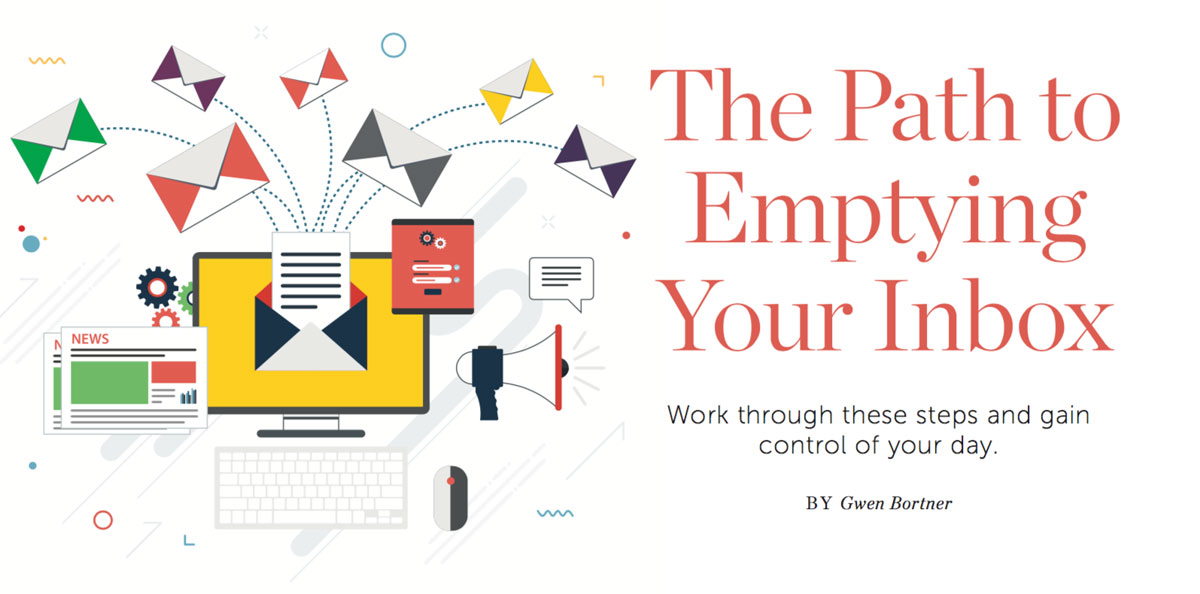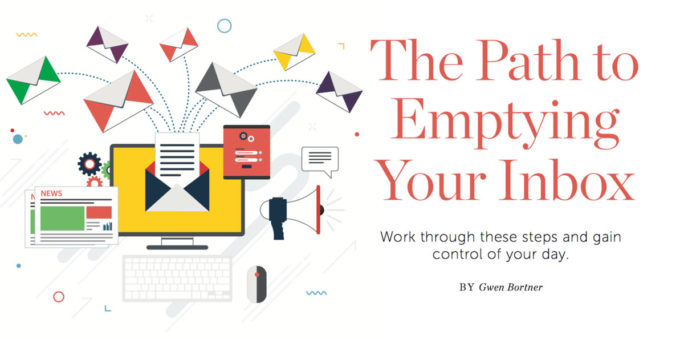Work through these steps and gain control of your day.
You may dream of having an empty inbox at the end of the workday. But your reality is likely to be dozens of messages arriving every day to vie for your attention. Some of those emails are both valuable and important, others are of interest but not critical (at least at the moment), and the majority fall into the categories of not urgent, limited interest or just junk mail.
What arrives in my inbox is much like yours, except the majority of the time, my inbox is empty or nearly empty (less than one full screen). But it wasn’t always that way, and it doesn’t always stay that way. Through the years I have received insights from productivity experts like David Allen, Michael Hyatt and Craig Jarrow, and I developed a number of tips, tricks and processes to get an inbox to empty and keep it there most of the time. The result is less stress concerning online communication, better customer service and greater personal productivity.
The Initial Push
To get to an empty inbox, most people need to do some analysis, change habits and invest most of one day to get to a good starting point.
Analysis
Taking the time to understand where you currently are may seem like a useless step, but it will help you understand how you got here and what needs to change to maintain an empty inbox. Begin by figuring out how things really are.
- How many messages are in your inbox?
- How old are the oldest messages?
- How many new messages do you receive each day?
- What are the broad categories (task based, informational, to be read later, etc.) of emails that clog your inbox?
- Do you have a filing/organization/processing system?
- Does the filing system need to be revamped for your current environment and situation?
The first three items help to see the problem from a broad perspective.
Item 4 is critical to understanding where you get hung up in processing email. Try to answer this question with a high-level overview. There may be more than one major group, but it likely won’t be more than three.
The last two items are critical in maintaining an empty inbox going forward. Certain items should be filed and grouped logically. For many people, the filing system is where they need to invest the most time.
Choose the Initial Path
When you are ready to make the commitment to an empty inbox, set aside several hours or possibly a full day. To get started, choose from three options
- Fix the problem. Start processing every email currently in your inbox using the system summarized below. This is the most time-consuming option, but also provides the most insight. Commit to keeping at it until it is ALL done. Expect to spend 15 to 30 seconds per email.
- Declare email bankruptcy. This method, developed by author Michael Hyatt, is based on the belief that if you haven’t dealt with the emails, they aren’t important and therefore it is reasonable to delete or archive (place in a folder with date information) everything and start fresh. This is drastic action, and most people struggle with the idea. If a clean slate is inviting but the wholesale clearing of your inbox seems like too much, consider the next option.
- Do a combination of both. This is my personal favorite and the preference of most of my clients. Pick a time frame (not less than one month and not more than three months) and either delete or archive all messages older than that. Review the remaining messages as you would in option 1.
Process Your Email
Although we refer to processing email as part of the initial push, this is also the method you will use daily going forward to maintain your empty inbox.
Begin by looking at your answer to item 4 above. Are there types of emails that could be managed automatically by setting up rules within your email system? If so, set them up and run them on the inbox to see what gets handled. For example, if you receive notifications of payments from an online processing system, those could be automatically filed in a specific folder and dealt with at the appropriate time without ever landing in your inbox.
Of what remains, emails will generally fall into three general categories:
- Delete (no longer needed).
- Reference (may want to go back to later).
- Action (you are expected to “do” something).
Delete Is NOT a Folder
First, let’s be clear about the idea of deleting. Just because there is a delete folder doesn’t mean you should treat it like part of the filing system. If you are deleting an email, you should be comfortable with never seeing it again. As such, you should either set your options to empty the delete folder upon closing the application or set a task to do so manually on a regular basis.
Delete is the first option in processing your email. If the message doesn’t require any action from you and you don’t need/want to keep it for reference, then delete it. Don’t be afraid of the delete option. Often you just need to get the update and then you are done. If the item is an online newsletter you are no longer interested in receiving, invest the few extra moments to unsubscribe to avoid having to take time to delete it going forward.
Save for Reference
Lots of information that arrives in our inbox doesn’t require a specific action on our part, but we feel compelled to save it for reference. This is where an effective filing system is important.
Data storage options are such that you can probably keep everything you could possibly want. The trick is knowing where to find it later. For your filing system to be effective, it must be simple enough that you will use it consistently and know where emails should be filed. Fewer folders is better. If you need to find something, the search function is very powerful and will usually locate what you need in short order. Also remember the folder system is dynamic; you can make adjustments (add, delete or consolidate) as you deem necessary.
Take Action
Surprisingly few emails actually require that you take action. Action can be doing something now, doing something later or delegating to someone.
For as many emails as possible, at the time of processing complete the action so you can move it out of your inbox. This may be scheduling a meeting, putting a task on your task list, making a phone call or replying with a brief answer.
In some cases, leveraging tools from other applications will allow you to quickly move something from your inbox into a form that makes more sense; for example, adding the necessary action to your task-management application. Set up template responses for common questions or actions. Even if the responses require some customization, the time invested in creating the templates will come back to you multifold.
If an email calls for research or deep thought before responding or it makes sense to batch it with other similar actions, it falls into the “do something later” category. Create a file for these emails and review them on a regular basis (daily or weekly depending upon the nature of the email). This may be more than one folder, depending on the topic, but it is critical that time be set aside so they get reviewed and responded to.
The last action is to delegate the requested action. If you want to ensure delegated items are completed, move the item to a delegation folder that you follow up on weekly.
Maintaining an Empty Inbox
Once you have completed the initial processing, you must commit time (usually at the beginning or end of the day) to the processing step daily. Estimate 30 to 60 seconds per email to determine a block of time that seems reasonable. If you miss a few days, set aside more time.
You may find your overall productivity improves if you keep email turned off most of the day and only check in at designated times. If you do keep the application on, turn off all notifications on all devices on which you receive email. Focused efforts, including responding to email, are much more productive.
If in the future, your inbox gets out of control again, don’t give up. Block a chunk of time to complete another initial push and move forward from there.
An empty inbox is not an impossible mission. With your initial investment of time and a commitment to diving in most every day, you will develop a whole new relationship with your email communications.You will spend less time and be more responsive, resulting in increased productivity. So schedule your initial push. An empty inbox is waiting.
 |
Gwen Bortner is a business consultant focused on the craft enthusiast industry. For more information on how she helps her clients build profitable businesses and to get more down-to-earth business advice, click here. |





